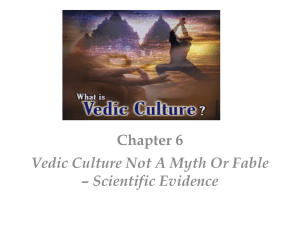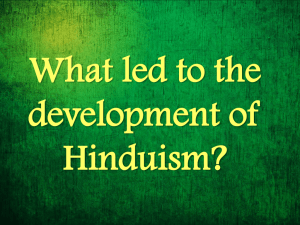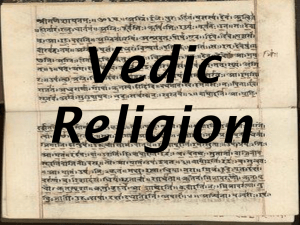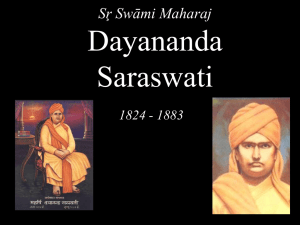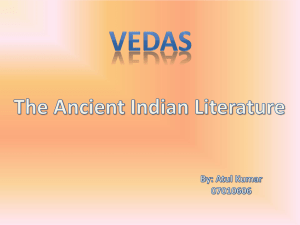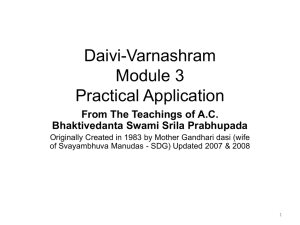to view ppt
advertisement
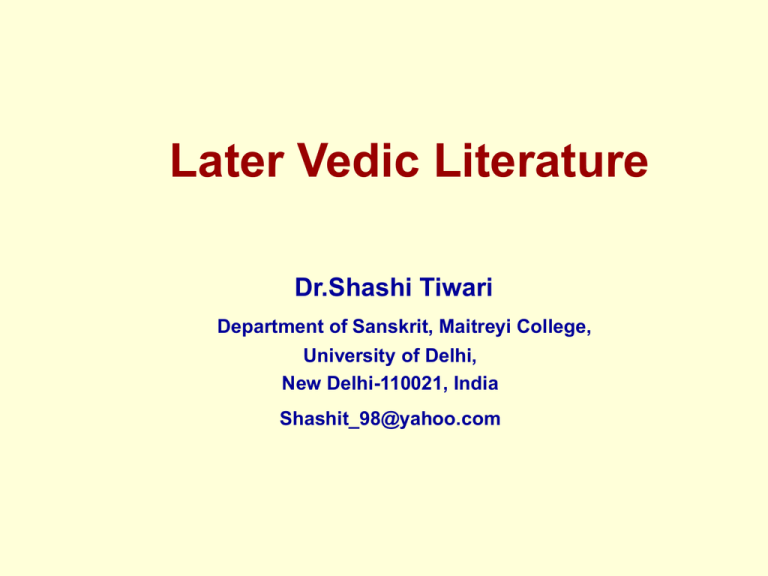
Later Vedic Literature Dr.Shashi Tiwari Department of Sanskrit, Maitreyi College, University of Delhi, New Delhi-110021, India Shashit_98@yahoo.com Introduction • • • • Vedic literature has texts of four types All are designated as 'Vedic' First are Samhita texts Each Samhita has corresponding: 1.Brahmanas, 2.Aranyakas, and 3. Upanishads 2 Four Vedic Priests • • • • Vedic Priest is called Ritvij in a ritual The Rigveda - Hota Ritvij - invokes deities Yajurveda – Adhvaryu Ritvij– offers oblations in ritual fire Samaveda- Udgata Ritvij- sings Samans Atharvaveda- Brahma Ritvij – overall in charge of ritual 3 Two Categories- Later Literature 1. Vedic TextsBrahmanas, Aranyakas and Upanishads 2. Vedangas (six subjects)Shiksha, Kalpa, Vyakarana, Nirukta ,Chanda, Jyotisha = Phonetics, Rituals, Grammar, Etymology, Metrics and Astronomy. 4 Purpose of Later Vedic Literature • “After the sacred and revealed Vedic Mantra texts, • there is another class of Vedic texts, • which are closely connected with the Vedic mantras, • and are helpful for reading and understanding them”. 5 Classification of Vedic Texts VEDA >SAMHITA > BRAHMANA > ARANYAKA > UPANISHAD 1.Rigveda- RigvedaSamhita > Aitareya-Brahmana> Aitareya Aranyaka >Aitareya Upanishad 2.Samaveda -Sama Samhita> Pancavisha- Brahmana> TalavakaraAranyaka >Chandogya-Upanishad 3.Yajurveda 1.Shukla-Yajurveda>Shatapatha-Brahaman>Brihdanyaka > Ishavasya-Upanishad 2.Krishna-Yajurveda>Taittiriya-Brahaman > Taittiriya AranyakaTaittiriya Upanishad 4. Atharvaveda – Atharvaveda Samhita > Gopatha- Brahmana > X >Mundaka Upanishad 6 I. The Brahmanas (1) 'Veda' made up of Mantra and Brahmana 7 Brahmanas - Meaning (2) • The word in neuter gender means Brahmana texts. • "Which in tradition is not a hymn or a Mantra is a Brahmana and which is not Brahmana is a Mantra".- Sayana • "Brahma Vai Mantrah" -'that which relates to Brahman or the Veda'. 8 Brahmanas- Ritual books (3) A Yajna being performed on Vedic Alter 9 Brahmanas -Contents (4) • • • • • • Used for the performance of sacrificial rites Six topics given by Apastamba : 1. Vidhi - injunctions for the performance of rites 2. Arthavada- explanatory remarks 3. Ninda - criticism, refutation of views 4. Prashansha- eulogy, praise 5. Purakalpa - performance of former times 6. Parakriti- achievements of others 10 Brahmanas -Contents (5) • • • • • • • • • • 1. 2. 3. 4. 5. 6. 7. 8. 9. 10. Hetu - reasons Nirvacana - etymology Ninda - censure Prashansha - eulogy Sanshaya - doubt Vidhi - injunction Parakriya - deeds/feats of others Purakalpa - legendary background Vyavadharana-Kalpana - managerial application Upamana - illustration. = 10 topics By Shabara 11 Brahmanas - Classification(6) Sixteen Brahmanas available today • Rigveda : • • Shukla-yajurveda : Shatapatha =1 Krishna-Yajurveda : Taittiriya =1 • Samaveda: • Atharvaveda : Gopatha = 1 Aitareya/Kaushitaki. = 2 (5) Tandya etc. =11 12 II. Aranyakas- Nature (1) • The concluding portions of the several Brahmanas, • But distinct category of literature, • Due to distinct character, contents and language • Aranyaka literature is rather small • Deal with philosophical speculations ( Jnana-Kanda) 13 Aranyakas - Meaning (2) Derived from the word 'Aranya' (forest) • The texts to be read in forest Aranyadhyayanad-etad –aranyakamitiryate - Sayana • Brahmanas advocate sacrifices for Grihastha • Aranyakas describe rituals for Vanprasthas 14 Aranyakas-Contents (3) • • • • • Main subjects : Theosophy (Brahmavidya)/ Meditation (Upasana) /Knowledge of breath (Pranavidya) Secret meaning of the sacrifices Stories & dialogues - Maitreyi &Yajnavalkya Bridge between Karma-kanda (Br.) & Jnana-kanda(Up.) Give geographical, historical, cultural points 15 Aranyakas- Classification(4) • • • • • Seven Aranyakas available. Rigveda : Aitareya/Kaushitaki -2 Samaveda : Talavakara/ Chandogya -2 Shukla Yajurveda : Brihadaranyaka -1 Krishna Yajurveda : Taittiriya -2 No Aranyaka of Atharvaveda 16 III. Upanishads - Nature (1) • Concluding part of the Veda • Called 'Vedanta'. - Vedasya antah, - the conclusion (Anta), or - the goal (Anta) of Vedas • Upanishads are the ripe fruits of Vedas • Jnana-Kanda dealing with knowledge • Most popular Vedic texts in world 17 Upanishads -Meaning (2) • • • • • Word derived from Upa+ Ni+ Sad (to sit) means 'sitting very near to a teacher devotedly'. secret teaching/ doctrine (Rahasya/ Guhya ) Constant association of Guru with Antevasin High moral character of student (Tapas/Yama/Niyama) • High knowledge of Guru (Shrotriya & Brahmanishtha) 18 Upanishads - Number (3) • Old Upanishads & Later Upanishads • Samhita Upanishad – Ishavasya- YU 40th • Later additions by religious sects for scriptural authority • Allah Upanishad, 16th A.D., time of Akbar • Generally 108 Upanishads • Ten -Principal Upaniashads- 'Dashopanishad' : • Isha, Kena, Katha , Prashna , Munda , Mandukya, Taittiriya, Aitareya, Chandogya and Brihadaranyaka - states Muktikopanishad 19 Upanishads - Division (4) • • • • • Principal thirteen Upanishads: Rigveda : Aitareya , Kaushitaki -2 Shukla-Yajur : Brihadaranyaka ,Isha -2 Krishna-Yajur : Taittiriya , Katha, Shvetashvatara, Maitrayaniya -4 Samaveda: Chandogya, Kena -2 Aharvaveda: Mundaka, Mandukya, Prashna -3 20 Upanishads - Theme (5) Brahma-Vidya /Jyana- kanda • Religious and philosophical treatises • Represent knowledge of Brahman • Ekam sad vipra bahudha vadanti ' -RV • Mark the culmination of Vedic wisdom • Basically Anti-ritualistic. 21 Upanishads - Importance (6) Unique place in Indian philosophy Foundation of Vedanta philosophy Adi Shankara, Commentator of Upanishads 22 Upanishads - Importance (7) Brahmavidya or the knowledge of Brahman • Give importance to 'Knowledge' alone • Any one with Jyana can be Guru or Acarya, is GREAT • Raikva instructed king Janashruti Chando.Up • king Pravahana instructed to Gautama • Ashvapati Kaikeya instructed to five Brahmanas 23 Upanishads - Great sayings (8) Mahavakyas : Establish the non-duality of Atman and Brahman • Prajnanam Brahma -Rigveda • Aham Brahmasm -Yajurveda • Tattvamasi - Samveda • Ayamatma Brahma -Aharvaveda 24 IV.Vedangas –Nature (1) Vedangas: last treatises of Vedic Literature Veda Purusha have six limbs as six Vedangas : • Chandas are His two feet, • Kalpas are His two arms, • Jyotisha are His eyes, • Nirukta is His ears, • Shiksha is His nose & • Vyakarana is His mouth. -Paniniya Shiksha (41-42) 25 Vedangas –Purpose (2) • (1)Shiksha or phonetics or pronunciation • (2)Kalpa or ritual • (3)Vyakarana or grammar • (4)Nirukta or etymology • (5)Chandas or meter • (6)Jyotisha or astronomy 26 Vedangas –Shiksha (3) Shiksha -Nose of Veda Purusha • It means instruction: Instruction in reciting, correct pronunciation, accents • Shiksha-Sutras - texts on phonetics • Phonetics is important for Vedic language • Some Pratishakhyas are : Rigveda-Pratishakhya /Taittiriya-Pratishakhya / Aharvaveda-Pratishakhya 27 Vedangas –Kalpa (4) • • • • • Kalpa (ritual) - Arms of Veda Purusha Systematic treatment or rituals, rules for sacrifices Four types of the Kalpasutras:— Shrauta-sutras, dealing with Shrauta sacrifices Grihya-sutras, dealing with domestic ceremonies Dharma-sutras, dealing religious, social laws Shulba-sutras, dealing measurement of altars 28 Vedangas –Vyakarana (5) Grammar- mouth of Veda Purusha • • • • Discuss (Prakriti) and suffix (Pratyaya) Old Vedanga-texts on Vyakarana are lost Aranyakas give some technical terms Ashtadhyayi of Panini( of later period), fourteen Sutras called Maheswara Sutras, originated from Nataraja's damuru sound • Vararuci – Vartika, Patanjali- Bhashya 29 Vedangas –Nirukta (6) • • • • Nirukta -ears of Veda Purusha 'Nirukta' means 'etymology'- helps to know meaning of words Only work survived is Nirukta of Yaska Commentary on Nighantu - list of Vedic words and name of Deities Yaska mentioned his predecessors Galava, Shakapuni, Katthakya 30 Vedangas –Chandas (7) Chandas - Feet of Veda Purusha • Important to know Chandas of a Mantra, just as Devata • Term Chandas is derived from the root Chad (to cover) • Chandas covers the sense of the Mantra • Some texts, dealing with Vedic meters: Rikpratishakhya / Shankhayana Shrauta-sutra / Nidanasutra of Samaveda/ Chandas-sutras of Pingala 31 Vedangas –Jyotish (8) • • • • • Jyotisha - Eye, organ of sight of Veda Purusha It is not to teach astronomy but to fix days and time of sacrifices It gives rules for calculating time for sacrifices No work available of Vedic astronomy (Jyotisha) Maharshi Lagadha is known as author Vedanga Jyotisha Later Bhaskaracharya, Varahamihira and Aryabhatta are well known in Jyotish 32 Conclusion • The Anukramanis or systematic indices and Prishishtas or appendices are the last portion of Vedic Literature. • Vedic Literature is compact in all sense. • It presents varied and comprehensive wisdom of Vedic seers. 33 OM Thank You 34
